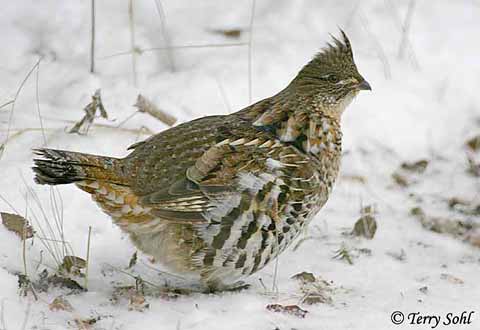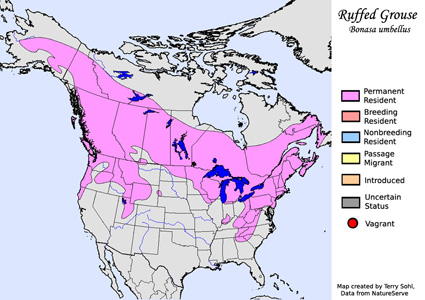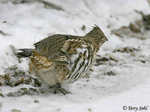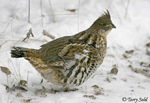| Length: 17 to 18 inches | Wingspan: 22 to 25 inches | Seasonality: All Seasons |
| ID Keys: Short crest, fan-shaped tail with black band near tip, barred underparts | ||
 The
Ruffed Grouse is the most widespread and common grouse, and can be found
throughout much of Canada, the extreme northern U.S., and higher elevations in
the U.S. An extremely low-pitched "drumming" sound is given by the male in
spring, and can be heard over half a mile away. Two color morphs exist,
the more common gray morph, and the red morph (which is found primarily in the
Appalachians, and the Pacific Northwest).
The
Ruffed Grouse is the most widespread and common grouse, and can be found
throughout much of Canada, the extreme northern U.S., and higher elevations in
the U.S. An extremely low-pitched "drumming" sound is given by the male in
spring, and can be heard over half a mile away. Two color morphs exist,
the more common gray morph, and the red morph (which is found primarily in the
Appalachians, and the Pacific Northwest).
Habitat: Can be found in a variety of forest types, but generally prefers mixed forests of conifer (for shelter) and deciduous (for foraging). On occasion they can be found in pure conifer forest.
Diet: The majority of the diet is plant material, including seeds, berries, leaves, buds, flowers, and fresh shoots. They will also eat insects, spiders, snails, and occasionally small reptiles or amphibians.
Behavior: Will forage on the ground, in shrubs, or even high in trees. They can often be quite tame.
Nesting: May through July
Song: Ruffed Grouse Call
Migration: A semi-permanent resident, with birds making short moves between more open areas during breeding season to denser cover in the winter.
Interactive eBird Map: Click here to access an interactive eBird map of Ruffed Grouse sightings
Similar Species: Blue Grouse, Spruce Grouse. Ruffed Grouse are most likely to be confused with females of these two species, as the males are more distinct.
Conservation Status: Generally stable throughout its range, with natural local population fluctuation.
Further Information: 1) USGS Patuxent Bird Identification InfoCenter, Ruffed Grouse
2) Ruffed Grouse - Audubon Field Guide
Photo Information: December 14th, 2005 - Sax-Zim Bog in Minnesota - Terry Sohl
Additional Photos: Click on the image chips or text links below for additional, higher-resolution Ruffed Grouse photos.
| Click on the map below for a higher-resolution view |
 |
| South Dakota Status: Uncommon permanent resident in the Black Hills. |
Additional Ruffed Grouse Photos
Click for a higher-resolution version of these photos


